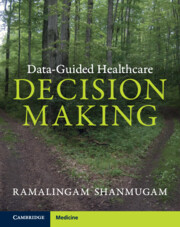Book contents
- Data-Guided Healthcare Decision-Making
- Data-Guided Healthcare Decision-Making
- Copyright page
- Dedication
- Contents
- Figures
- Tables
- About the Author
- Preface
- Glossary
- Notations and Symbols
- Prologue
- Introduction
- Chapter 1 Why and How Healthcare Decisions Are Made
- Chapter 2 Are Data-Guided Healthcare Decisions Superior?
- Chapter 3 Software
- Chapter 4 How to Collect Authentic Data
- Chapter 5 Uncertainties and Their Impact on Healthcare Decisions
- Chapter 6 Why Models Are Important in Healthcare
- Chapter 7 How Healthcare Decision Trees Emerge and Function
- Chapter 8 How Are Group Decisions Practiced in Healthcare?
- Chapter 9 Tracing and Remedying Root Causes of Adversities
- Chapter 10 Healthcare Decision-Making for Cost-Effectiveness
- Chapter 11 Risk Analysis in Healthcare Decision-Making
- Chapter 12 Evaluation of Healthcare Programs
- Chapter 13 Six Sigma and Lean Management in Healthcare Sectors
- Chapter 14 Forecasting in Healthcare Sectors
- Epilogue
- Appendix Statistical Tables
- Index
- References
Chapter 5 - Uncertainties and Their Impact on Healthcare Decisions
Published online by Cambridge University Press: 13 July 2023
- Data-Guided Healthcare Decision-Making
- Data-Guided Healthcare Decision-Making
- Copyright page
- Dedication
- Contents
- Figures
- Tables
- About the Author
- Preface
- Glossary
- Notations and Symbols
- Prologue
- Introduction
- Chapter 1 Why and How Healthcare Decisions Are Made
- Chapter 2 Are Data-Guided Healthcare Decisions Superior?
- Chapter 3 Software
- Chapter 4 How to Collect Authentic Data
- Chapter 5 Uncertainties and Their Impact on Healthcare Decisions
- Chapter 6 Why Models Are Important in Healthcare
- Chapter 7 How Healthcare Decision Trees Emerge and Function
- Chapter 8 How Are Group Decisions Practiced in Healthcare?
- Chapter 9 Tracing and Remedying Root Causes of Adversities
- Chapter 10 Healthcare Decision-Making for Cost-Effectiveness
- Chapter 11 Risk Analysis in Healthcare Decision-Making
- Chapter 12 Evaluation of Healthcare Programs
- Chapter 13 Six Sigma and Lean Management in Healthcare Sectors
- Chapter 14 Forecasting in Healthcare Sectors
- Epilogue
- Appendix Statistical Tables
- Index
- References
Summary
First, let us examine the role of uncertainty in scientific inquiries in general and in healthcare decision-making in particular. Weurlander (2020) warns physicians to be careful to deal with uncertainty before making decisions to treat patients. Koffman et al. (2020) discuss reasons for involving uncertainty in healthcare, especially with respect to the COVID-19 pandemic. Uncertainty is not easily defined because of inadequate, incomplete, and ambiguous information.
Many occurrences in personal and professional life exhibit patterns of complete unpredictability – climate, disease outbreaks, financial volatility, natural disasters. Especially in healthcare, a specified outcome might be seen or missing. This vagueness is framed as uncertainty and raises fundamental challenges. Understanding how uncertainties appear is perhaps the beginning of solving this issue. Like an atom can be decomposed to its constituent parts of electrons, neutrons, and protons, the probability of uncertainty can be decomposed to its axioms. Refer to Camio et al. (2019) and Scoones (2019) for more discussion of how uncertainty is identified and illustrated.
- Type
- Chapter
- Information
- Data-Guided Healthcare Decision Making , pp. 107 - 155Publisher: Cambridge University PressPrint publication year: 2023



